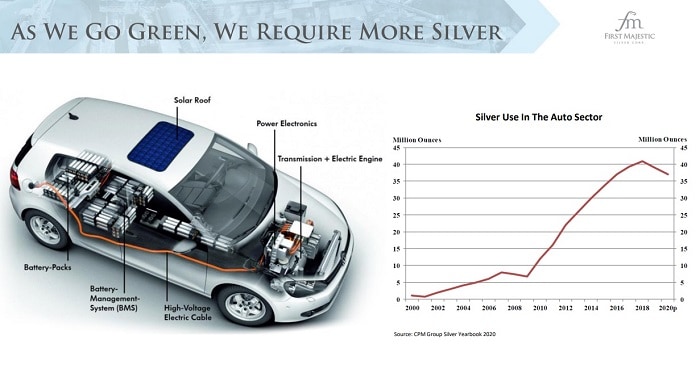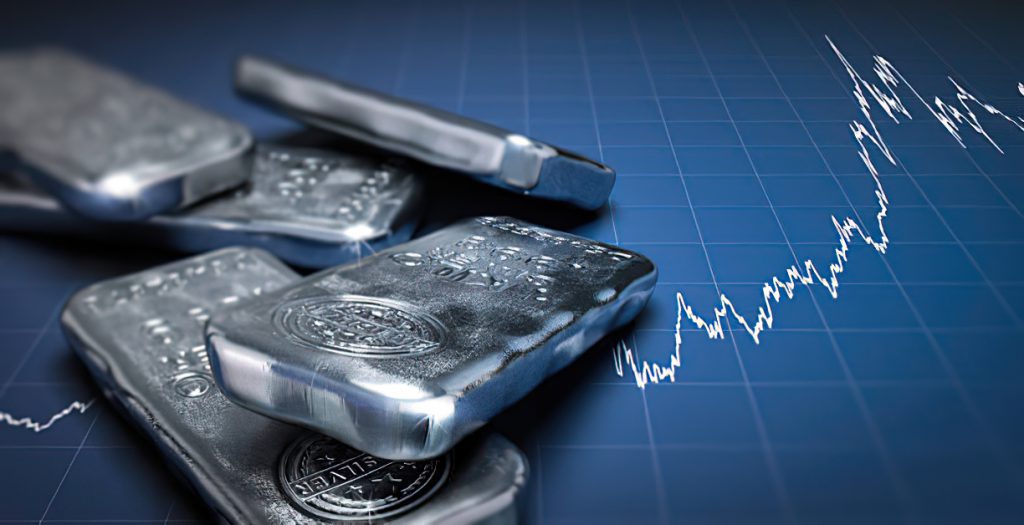Silver plays a crucial role in meeting the demand of various industries. Its unique properties, including high electrical and thermal conductivity, make it indispensable in electronics, solar panels, and medical applications. This blog explores the significance of silver in fulfilling industrial needs and driving technological advancements.
Silver is among the most traded commodities in the world. It is a precious metal that has been used by humanity for millennia now. Silver is intrinsic to industrial demand in sectors such as electronics, medicine, etc. Infact, more than half of all silver consumption is for industrial purposes.
It is primarily produced as a by-product in the production of other metals such as zinc, lead, copper, and gold. Almost 4/5th of all silver production is as a by-product, with exclusive mining accounting for only 20% of overall global silver production.
Silver often called the poor man’s gold, has seen an upthrust in the demands in recent years. As the industrial sector in India matures, the demand increases. Demand has been steadily increasing for industrial needs over the years.
Compared to gold rates, silver rates in India have been relatively undervalued. This is evident from the high ratio of gold to silver prices as compared to the past. As such, investors are looking at the long-term potential of this precious metal in terms of returns compared to its pricier cousin gold.
It is an important precious metal of:
- great antiquity
- increasing industrial applications
- highest electrical conductivity
- thermal conductivity
- the reflectivity of any metal
Silver as an Industrial Commodity
This is a very useful metal apart from being a precious metal. The primary demand for it comes from industrial usage. It is used in the production of almost every electronic device such as tablets or smartphones. Silver’s industrial demand had risen four-fold through the early to late 20th century.
Silver has:
- High thermal conductivity as well as electrical conductivity
- More versatile than copper, which has ingrained it in a large list of daily usage products such as alarm clocks, computers, cellphones, plumbing, wall switches, bathroom mirror, microwave, dishwashers, and the manufacturing of polyester clothing.
- An intrinsic element in the production of photovoltaic cells useful in automobile components and solar panels.
- As a cathode in batteries and also in membrane switches in TVs. Silver oxide cells can be found in the manufacturing of hearing aids, toys, cameras, calculators, etc.
- Become a mainstay in the production arena of indoor plumbing, cars, electricity, and aerospace technology.
- More environmentally friendly than lithium-ion batteries and is useful in electric cars, and consumer electronics, etc.
- Used in the soldering and brazing of metals.
- Many useful physical and chemical properties in varied industrial applications including the electrification of vehicles (EVs), 5G mobile phone technology, and importantly commitment of various governments to invest in ‘green’ infrastructure.
Applications in the Automotive sector
Silver will benefit from applications in the automotive sector – for example, in electrical contacts, microprocessors, memory and circuit boards, and radar and camera sensors.
The Silver Institute estimates that silver demand from the automotive industry will reach 88 million ounces by the middle of this decade (up from just over 60 million ounces in 2021). In 2040, electric vehicles could even devour almost half of the annual silver supply (a good 1 billion ounces).
- Silver is essential in various automotive applications due to its superior electrical properties for safety and meeting tougher environmental standards.
- In battery-powered vehicles, the use of silver will be markedly more than in conventional vehicles, used in charging stations, power generation, and other supporting infrastructure.
- The installation of solar systems is driving the demand for silver higher.
- The photovoltaic sector is currently demanding around 100 million ounces of silver annually. Some experts forecast an increase in silver demand to 185 million ounces over the next ten years from the photovoltaic industry.
The Government of India should take cognizance of the emerging scenario. Demand within the country is likely to grow rapidly with policy thrust on EVs and solar energy. As import dependence on the metal is set to increase it is necessary to work towards augmenting silver supplies from a long-term perspective.
Electrical and Electronics Industries
Silver is an excellent conductor of electricity, making it an essential component in the electrical and electronics industries. It is widely used in the production of switches, circuit boards, and connectors. Additionally, silver is vital in the manufacturing of batteries, solar panels, and various electronic devices. Its high thermal conductivity also makes it valuable in the production of heat sinks and other cooling components.
Photography
Although digital photography has gained popularity, silver still holds significance in the photographic industry. Silver halide crystals are useful in traditional photographic films, where they capture light to create images. Moreover, silver is employable in the production of films used in X-rays and other medical imaging techniques.
Mirrors and Reflective Coatings
Mirrors play a significant role in our everyday lives, and silver industrial coatings are crucial for their functionality. Silver, known for its high reflectivity, is commonly used in mirror manufacturing. These reflective coatings consist of a thin layer of silver deposited onto a glass surface. The silver coating allows mirrors to reflect light effectively, enabling us to see our reflections clearly.
Silver industrial coatings are also utilized in various industries, such as optics, solar panels, and automotive mirrors. Their exceptional reflectivity and durability make them a preferred choice. Overall, silver industrial coatings contribute to the production of high-quality mirrors and enhance their reflective properties.
Catalysts
Catalyst is a crucial component in various industrial processes, including the silver industry. Silver, a versatile metal with numerous applications, relies on catalysts to enhance its production and purification processes. Catalysts play a significant role in accelerating chemical reactions and increasing efficiency, reducing the energy requirements and costs associated with silver production.
In the silver industrial sector, catalysts are employed in various stages of the production process. They facilitate the extraction of silver from ores, aid in the refining and purification of silver, and contribute to the development of advanced silver-based materials and products.
Catalysts used in the silver industry are designed to optimize reaction conditions, increase yield, and minimize unwanted by-products. They enable the conversion of raw materials into high-quality silver products, ensuring consistent purity levels and meeting industry standards. The use of catalysts in the silver industrial sector not only improves the overall production efficiency but also promotes sustainability by reducing waste generation and minimizing environmental impact.
Antibacterial Properties
Silver has long been recognized for its antibacterial properties, making it a valuable asset in various industries. In the industrial sector, silver finds extensive use due to its ability to inhibit the growth of bacteria. It is commonly incorporated into products such as medical equipment, water purification systems, and even textiles.
The antibacterial properties of silver are attributed to its ability to release silver ions, which have a toxic effect on bacteria. These ions disrupt bacterial cell membranes and interfere with their metabolic processes, ultimately leading to their demise. This makes silver an effective weapon against a wide range of harmful bacteria.
In the medical field, silver is useful in wound dressings and surgical instruments. It is to prevent infections and promote healing. In water purification systems, you use Silver to kill bacteria and other microorganisms present in water sources. Additionally, textiles treated with silver nanoparticles can prevent the growth of odor-causing bacteria, keeping fabrics fresh for longer periods.
Water Purification
Silver has been widely used in the industrial field for water purification purposes. Its antimicrobial properties make it an effective agent in killing bacteria, viruses, and other harmful microorganisms present in water. The use of silver in water purification systems helps to prevent the growth and spread of waterborne diseases.
In the industrial sector, you utilize silver in various forms such as silver-coated filters, nanoparticles, or ion exchange resins. These materials are incorporated into filtration systems to target and eliminate contaminants from the water supply.
Silver’s effectiveness in water purification lies in its ability to disrupt the cellular structure of microorganisms, inhibiting their growth and reproduction. It acts as a powerful disinfectant, ensuring that water is safe for consumption and industrial processes.
Furthermore, the use of silver in water purification systems is due to its long-lasting effects. It provides a sustainable solution by continuously releasing silver ions into the water, maintaining its antimicrobial properties over time.
Silver Rates Affected by Industrial Demand
The industrial usage of silver thereby influences the prices of the commodity in a big way. Any pickup in economic activity worldwide spurs the prices of silver. Silver demand can even increase during times of severe recession. Silver is useful in three of the most basic requirements for humans – food, energy, and water.
As such, silver tends to show decent demand even during low economic growth. From photovoltaic cells to water purifiers, silver is present in one form or the other to make the appliance better.
Experts believe that this mismatch in price trends points toward oncoming high rates in the future. Admittedly, 2020 and 2021 were not good years for the metal because of slowing industrial production.
Disrupted supply chains, raw material bottlenecks, and markedly higher energy costs adversely impacted industrial output. As much as 50% of silver demand is accountable for industrial use.
The industrial metal character of silver is going to gain more traction in the years to come. While the 2022 demand outlook for silver looks constructive, the best would come in the years ahead.
Final Thoughts
Silver plays a crucial role in meeting the demands of various industries. Its unique properties, such as high electrical conductivity and thermal conductivity, make it indispensable in sectors like electronics, solar energy, and healthcare. With increasing technological advancements, the demand for silver is likely to grow, solidifying its position as a vital industrial metal.







